When the fall migration of hummingbirds begins, many people all over North America feel sad that their little friends will be absent from their gardens for a few months. But down south, the mass migration results in opposite, delighted feelings for the dedicated residents of Rockport and Fulton, Texas. To them, fall migration along the Central Flyway means that the little buzzing flyers will make one more major pitstop in the tiny coastal towns to rest and refuel before beginning their 500-mile flight nonstop across the Gulf of Mexico toward their winter habitats.
(A word about these photographs — try to find all the hummingbirds in each photo. Some of them are sneaky! Look for the vibrant throat colors to distinguish the males from the females.)
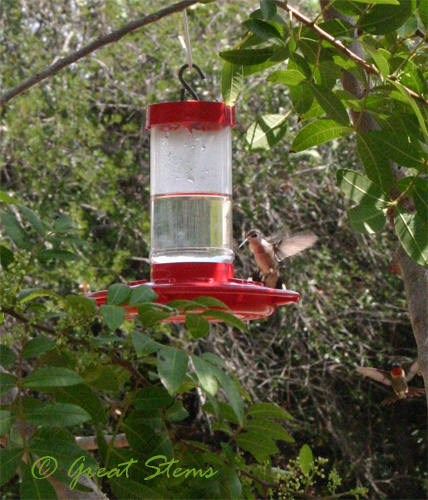
The town of Rockport is so enamoured with their feathered visitors that many years ago they began an annual event, the Rockport Hummer/Bird Festival, held each September unless a hurricane shows up and causes a cancellation (like Ike in 2008). This year was our first time attending the festival, and it was quite a relaxing, pleasant day (with an exception, noted farther down in this post). The event included many speakers and vendors, but the highlights were the hummingbirds themselves, and many kind Rockport residents opened their yards to festival visitors for hummingbird viewing. This year there were 25-homes on a self-guided tour, and for a fee, visitors could take a guided bus tour to many other private homes and grasslands areas.
A birdwatching festival is quite interesting and different from the perspective of one who’s been to all sorts of festivals, from family-filled celebrations of peaches to flowers, to Renaissance times, to chaotic state fairs. For one thing, it’s very quiet, as it should be if one hopes to observe the little birds without scaring them away. And another is that birdwatchers, while all ages, boast a higher percentage of an older crowd. My boys were two of the four children I saw at the festival, though to be honest we were there only on the last day of the event.

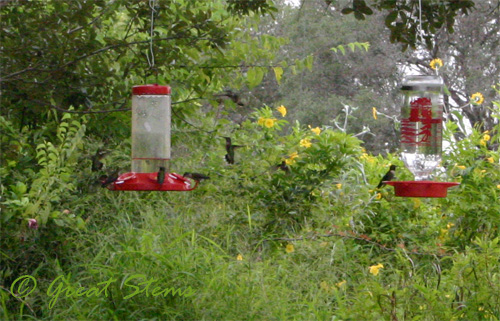 Rockport isn’t just about hummingbirds — hundreds of species of birds are year-round residents or migratory passers-through, and birdwatchers excitedly converge with binoculars in hand to enjoy the sheer numbers and to hopefully catch a glimpse of a rare species. At any given home on the hummingbird tours, there might be as many as 100 or more hummingbirds zooming about the feeders.
Rockport isn’t just about hummingbirds — hundreds of species of birds are year-round residents or migratory passers-through, and birdwatchers excitedly converge with binoculars in hand to enjoy the sheer numbers and to hopefully catch a glimpse of a rare species. At any given home on the hummingbird tours, there might be as many as 100 or more hummingbirds zooming about the feeders.
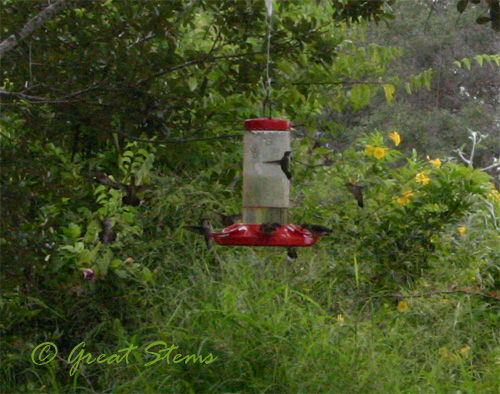
To help attract the birds, the town encourages residents to plant bushes and vines that are hummingbird favorites. There are a lot of Esperanza, for example. And there are other native plants, such as sunflowers and this pokeweed, that are enjoyed by other birds. If you look closely, you can see a remaining berry or two — the plants have been well-stripped by visiting birdies.
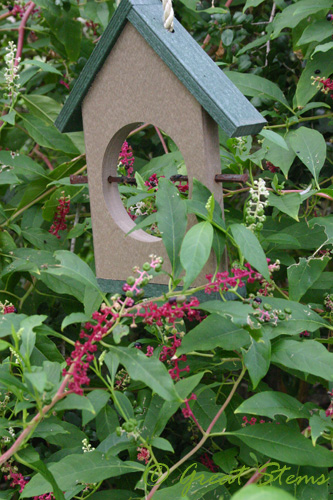
Along the self-guided tour, I felt drawn to those homes with wildscapes — native, flowering plants and small or large ponds helped draw in the wildlife. Of course, they had many a hummingbird feeder as well. At one home, my son counted 19 feeders, just in the backyard.
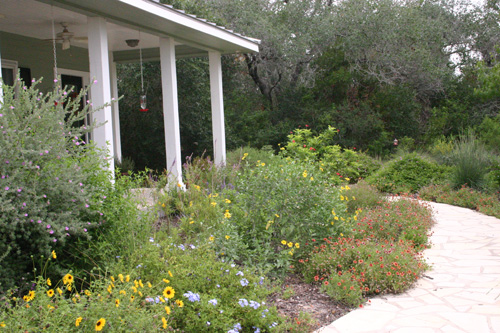
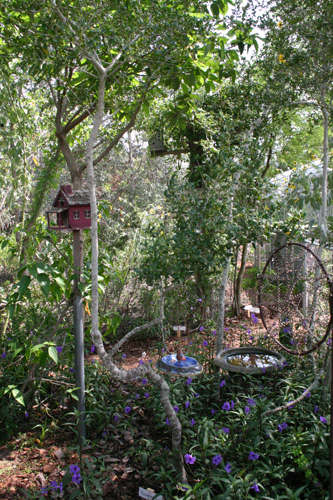
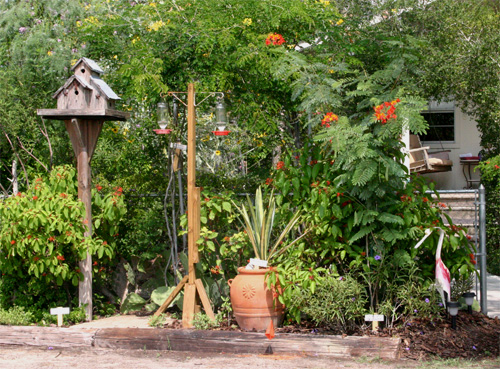 But there were a variety of landscapes on the tour, and there was even a school garden, planted and maintained by students and teachers.
But there were a variety of landscapes on the tour, and there was even a school garden, planted and maintained by students and teachers.
Experienced birders would sometimes call out when they spotted a particular species or another type of bird, such as an oriole. And we saw a beautiful Great Blue Heron, a Great Egret, and a large duck family, among other birds, scouring residential ponds for food.
At the festival, we enjoyed learning about the art of feeding hummingbirds from expert Sheri Williamson, author of an excellent field guide called Hummingbirds of North America. Sheri also went with a few of us to select homes on the tour, and it was wonderful to have a hummingbird expert on site to describe features and behavior of the hummingbirds and to answer any questions, of which it’s just possible that I might have had one or two… or three.
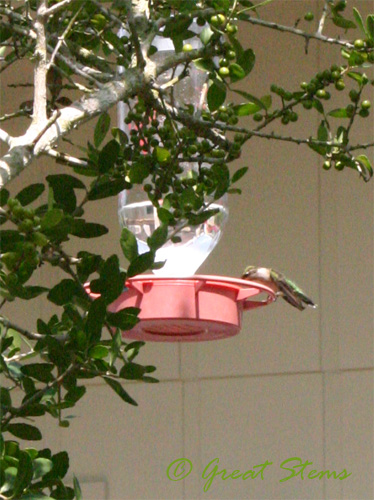 It was thoroughly entertaining watching the antics of the territorial hummingbirds. Their behavior is different at migration time — because the birds need to build up their energy stores, there is more willingness for many, but not all, of the birds to share a feeder from time to time. Despite the many feeders about a yard, the hummingbirds might swarm a particular feeder, as if they think that because others are that feeder, it must be good food. But territoriality is hard to resist sometimes, especially for the males. The vibrant color of the throats of the male birds was impressive, though Sheri said that these feathers are post-mating season, and thus less vibrant than at other times. Pretty cool.
It was thoroughly entertaining watching the antics of the territorial hummingbirds. Their behavior is different at migration time — because the birds need to build up their energy stores, there is more willingness for many, but not all, of the birds to share a feeder from time to time. Despite the many feeders about a yard, the hummingbirds might swarm a particular feeder, as if they think that because others are that feeder, it must be good food. But territoriality is hard to resist sometimes, especially for the males. The vibrant color of the throats of the male birds was impressive, though Sheri said that these feathers are post-mating season, and thus less vibrant than at other times. Pretty cool.
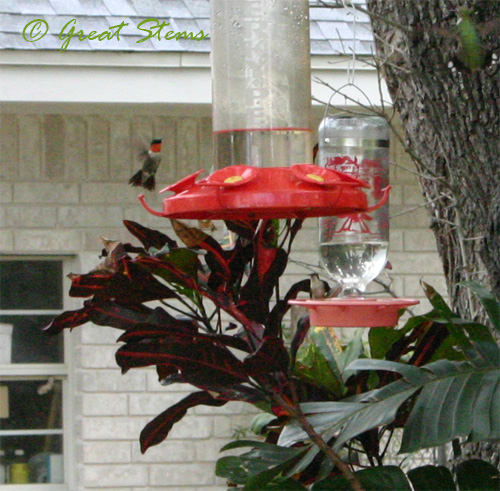 Sometimes the camera captured behavior my eye didn’t notice at the time. In the photo below, you can see two males squabbling, while another bird moves in to get some nectar.
Sometimes the camera captured behavior my eye didn’t notice at the time. In the photo below, you can see two males squabbling, while another bird moves in to get some nectar.
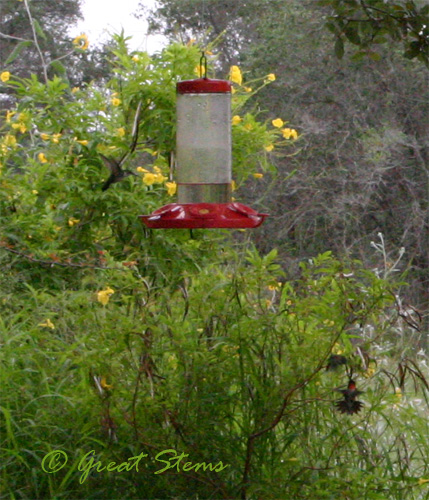 The majority of the hummingbirds that pass through Rockport are ruby-throated hummingbirds, but several species have been sighted, and in all more than 500 species of birds have been documented.
The majority of the hummingbirds that pass through Rockport are ruby-throated hummingbirds, but several species have been sighted, and in all more than 500 species of birds have been documented.
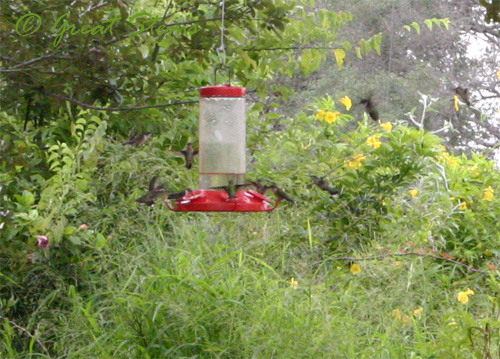 There was another creature that threatened to bring downfall to the festival this year, the heat-seeking, blood-sucking, mass-attacking mosquito. It was unbelievable the numbers of mosquitoes everywhere, and they swarmed every person by the hundreds. The mosquitoes were so bad at the very first house we stopped at that, that our hummingbird viewing would have come to an end before it started if we hadn’t decided to just go ahead and use some loaned icky chemical spray that I would never touch at home. But we were having to do a ridiculous and constant “Mosquito-Slapping Dance” until we finally used the spray, and if a green person is going to that extreme, you know it’s bad.
There was another creature that threatened to bring downfall to the festival this year, the heat-seeking, blood-sucking, mass-attacking mosquito. It was unbelievable the numbers of mosquitoes everywhere, and they swarmed every person by the hundreds. The mosquitoes were so bad at the very first house we stopped at that, that our hummingbird viewing would have come to an end before it started if we hadn’t decided to just go ahead and use some loaned icky chemical spray that I would never touch at home. But we were having to do a ridiculous and constant “Mosquito-Slapping Dance” until we finally used the spray, and if a green person is going to that extreme, you know it’s bad.
After using the spray, we could actually focus on the hummingbirds, until we went tried to get back in the car. This act required particularly quick moves and skill to minimize the number of mosquitoes that joined us in the vehicle — they hovered around the nice warm car until we showed up and opened the door, thinking we wanted them to join us inside. At one house at least fifty mosquitoes flew into the car, and we couldn’t get them out until we were on the highway and could roll the windows down enough to send them out, if we didn’t manage to smush them first. Note to self — avoid coast just after the first fall rain, haha.
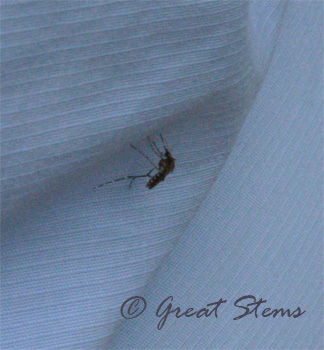 I have a much more disgusting picture of a mosquito, but I decided it wasn’t nice to share it on a garden blog, so I think I’ll gross out family members on the family blog instead.
I have a much more disgusting picture of a mosquito, but I decided it wasn’t nice to share it on a garden blog, so I think I’ll gross out family members on the family blog instead.
Rockport itself is an interesting coastal village. Near the water, the strong ocean winds have shaped the oak trees into quite the odd shapes. You can tell that salt and drought have taken their toll on the health of those trees.
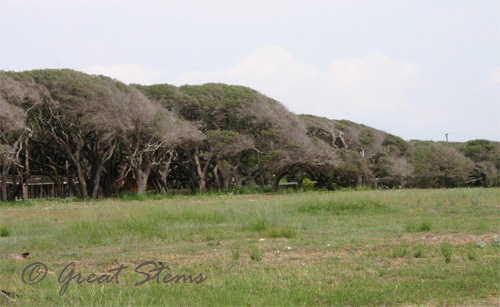
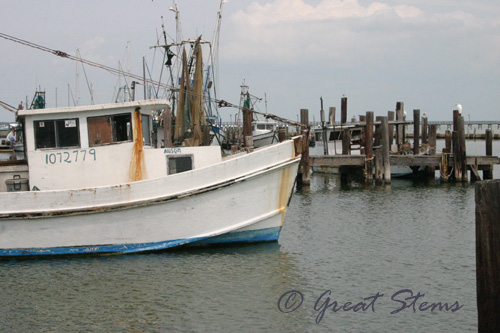 Outside of Moon Dog, where we had lunch, a lone pelican rested peacefully. It was quite the contrast to the zooming hummingbirds at the inland homes.
Outside of Moon Dog, where we had lunch, a lone pelican rested peacefully. It was quite the contrast to the zooming hummingbirds at the inland homes.
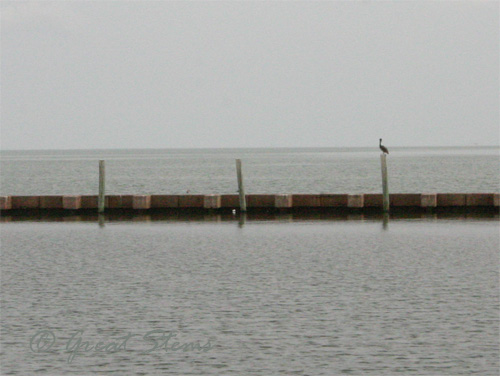
Back at the festival mall, we enjoyed visiting the vendor booths, but my grand plans to buy a couple of hummingbird feeders fell through — after looking around, I decided to stick with my favorite brand, HummZingers, but they didn’t have any there. I did get Sheri Williamson’s field guide, though. There were many jewelry, art, and other vendors, but we were looking for something that just “spoke to us,” as my husband put it. So we bought a buzzard, because that’s what one really goes to a hummingbird festival for, right? But even my husband wanted this buzzard — its head bobbles a bit in the wind.
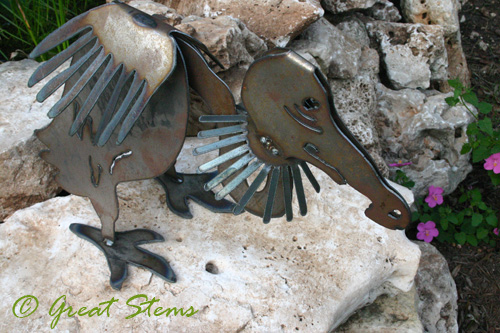 We’ll stick it somewhere particularly ominous for visitors passing by.
We’ll stick it somewhere particularly ominous for visitors passing by.
Wow! So many hummingbirds at one place! I would just sit and watch them for hours… Thank you Meredith for the pictures. I love the old boat pic, too.
interesting post! You must have seen tons on your tour. The bright throats of the males are very attractive indeed. I would love to lure some birds of any type my way, but unfortunately with our cat around, that’s just asking for trouble. The photo of the trees shaped by the ocean salt and winds was very interesting.
What’s also interesting is that not too far away is one of the most famous and gigantic live oak trees in the world, called “The Big Tree,” “Lamar Oak,” and “Goose Island Oak.” It’s supposedly more than 1,000 years old. Can you imagine all the history and weather it’s been through? Had I known about it while in the area, I would have made a special trip to see it. Next time!
I love this post! I wish I could’ve gone on that tour, minus of course the mosquitoes. We have the ruby throated hummingbirds here in Berkeley but they stay all year round. I love them so much and can watch them dive bomb each other all day long! Right now they’re fighting for my pineapple sage.
It’s great to read your post especially since your feature covers something we would have never known. Thanks for posting..!
*Urban Green waves at Meredith*
That was a terrific post! Well now I know where all my little summer hummers have gone. What a great day that must have been. You certainly made me want to visit Rockport.
Great post, Meredith! Hope you got away without too many bites. It was a pleasure to meet you at Rockport, and I look forward to reading more of your blog.
KD, your red-throated hummingbirds are actually Anna’s – very different from Ruby-throateds but equally fascinating. A researcher at UC Berkeley recently published a high-tech study showing how the tail feathers of males produce sounds by vibrating like a clarinet reed. You can read more about them on the Seattle Audubon Society’s BirdWeb.
Lucky – bird watching is so neat when there are so many to see. Even the mosquitoes are worth it, although I use bug spray freely – I’m pretty allergic to them. We’re gearing up for winter though, so enjoy our birdies!
First Hummingbird Festival I ever read about. I can’t think of a more deserving visitor to celebrate.
Thank you for finding my blog, so I could in turn search for you. We grow many of the same plants. I’m very fond of what I call ‘Texas Plants’ seldom seen in gardens around here, like Esperanza, Pride of Barbados and Bulbine.
Hi Meredith,
Another great post, would you be interested in a link exchange with us, I visit so frequently and find your posts so interesting, inspiration and educational. http://www.GardenersReach.com
Thanks in anticipation
What a delightful treat! I would love to go on a bird watching tour! Loved the homes too with all of the native gardens. And that mosquito just brings me shivers! I’m seeing them in my bedroom at night and if I can’t smash them, I have to pull my covers tight over my head so they won’t get me in the middle of the night 🙂
Thank you, Dragonfly Lady — you are so kind. I’ve thoroughly enjoyed Gardener’s Reach as well, and it’s on my bloglist. Also, check your e-mail when you have a chance!
Here in Nebraska I swa maybe 2-3 humers all year. I feel the most sad, though, when the last of the monarchs head south. Still hav one set to ome out this afternoon, and a few flitting in the garden. Lots of migrating birds already. Sigh.
It’s all part of the cycle, and their return will mark a change of season, as well. And with them will come spring flowers!
Hello Meredith,
I have a website and one of the articles that I wrote in the site was about the hummingbird festival. I would like know if you have pictures of the 2009 hummingbird festival to share with me. I will publish with your information in the site. Unfortunate I couldn’t go to the festival.
Sincerelly
Marina Benson
Thank you, Marina. I have replied to your query in an e-mail.